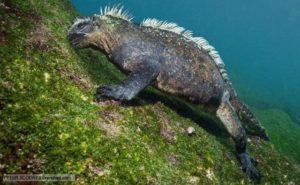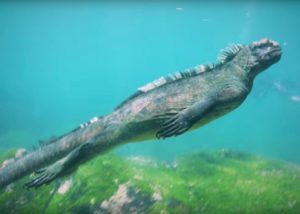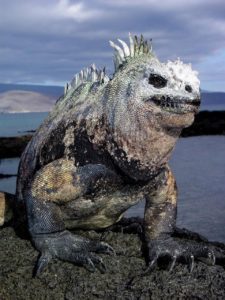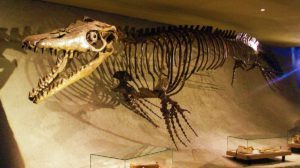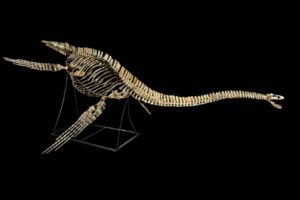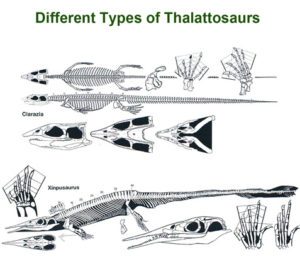Podcast: Play in new window | Download (Duration: 17:41 — 17.9MB)
Part of the scientific method involves making mistakes and correcting them. Here are some interesting and sometimes goofy mistakes made by paleontologists through the years, and how the mistakes were corrected.
Iguanodon did not actually look like this (left). It looked like this (right):
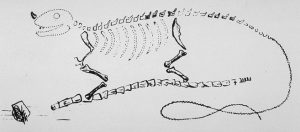
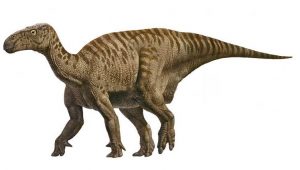
Pterosaur did not actually look like this (left). It looked like this (right):
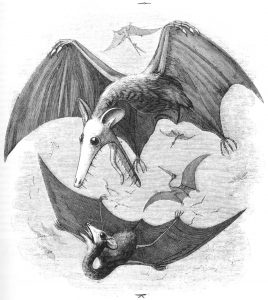
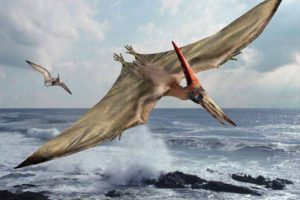
Elasmosaurus did not actually look like this (left). It looked like this (right):

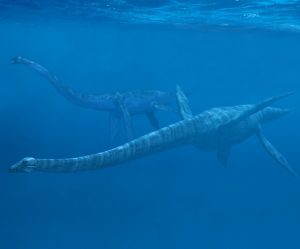
Apatosaurus/brontosaurus did not actually look like this (left). It looked like this (right):
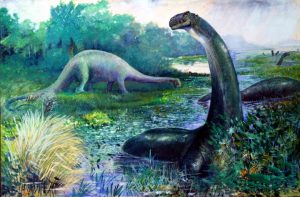
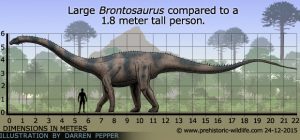
Stegosaurus did not actually look like this (left). It looked like this (right):
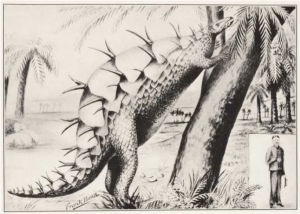
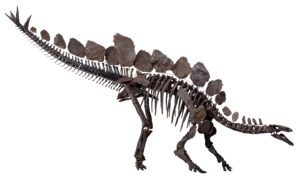
Gastornis did not actually look like this (left). It looked like this (right):
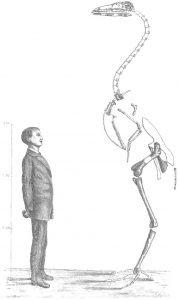
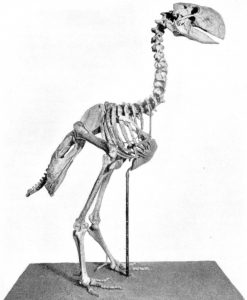
Those are Gastornis’s footprints:
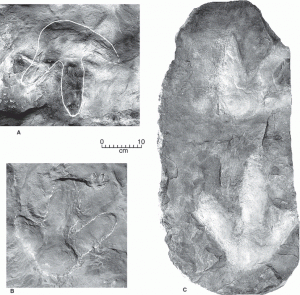
Show transcript:
Welcome to Strange Animals Podcast. I’m your host, Kate Shaw.
Paleontology is the study of fossils, and really it’s only been a discipline for a little over a century. Back in the 19th and early 20th centuries, even experts made major mistakes in preparing and assembling fossil skeletons, and dishonest amateurs made deliberate errors so their fossil animals looked bigger or scarier. Many of these mistakes or hoaxes were displayed in museums, sometimes for decades.
I found so many interesting examples during my research that I decided to split the episode into two. This week we’ll learn about some paleontological mistakes and what the fossil animals really looked like when they were alive. Next week we’ll look at the frauds and hoaxes.
We’ll start with Iguanodon, a dinosaur that lived around 125 million years ago in what is now Europe. It ate plants and was fairly common, with a number of species now known to science. The biggest could grow as much as 43 feet long, or 13 meters. It had teeth that resemble an iguana’s, which is how it gets its name, and a beak probably covered in keratin that it used to clip through tough plants. It probably mostly walked on two legs and browsed from trees, but its front legs were long and it might have spent at least some of its time on all fours. But the most interesting thing about Iguanodon was its hands. Its little finger was slender and usually longer than the others and many researchers think it was used for handling food and other objects. The first finger, which is equivalent to a thumb, wasn’t so much a digit as just a big spike. It’s called a thumb spike and no one’s sure what it was for. It might have been used for defense, but it might also have been used to help dig up plants. Maybe it was used for both. But it was the source of an embarrassing mistake that many paleontologists made for years.
Iguanodon came to the attention of science in 1822 when a medical doctor in Sussex, England found some fossilized teeth. No one was sure what kind of animal the teeth belonged to, although guesses ranged from a crocodile to a rhinoceros. In 1824 the doctor, Gideon Mantell, noted the teeth’s resemblance to iguana teeth, but so big that he estimated Iguanodon must have been almost 60 feet long, or 18 meters. He also thought Iguanodon looked like an iguana.
In 1834 more Iguanodon fossils came to light in a quarry and Mantell bought them. This incomplete skeleton included a thumb spike, but Mantell didn’t know where it belonged. He thought it was a horn, so when he made a drawing of the living animal, he placed the thumb spike on the nose.
And there it stayed, despite other fossils found with the thumb spike in place on the hand, and despite other scientists pointing out that they didn’t think Iguanodon had a horn on its nose. It wasn’t until 1882 that the nose horn vanished for good and Iguanodon started looking more like itself.
Similarly, pterosaurs have been misunderstood since the very beginning, with a lot of frankly ridiculous suggestions made about them. To be fair, they are really strange animals and nothing like any animal living today. The first pterosaur was described in 1784 by an Italian naturalist, but he thought it was a swimming animal and that its wing bones were actually flippers. Zoologist Georges Cuvier pointed out it was a flying reptile in 1801, but the swimming hypothesis wasn’t abandoned for decades after that. Even after the flying part was accepted by other researchers and the general public, many people believed they were related to bats for a remarkably long time. In 1843 one scientist suggested pterosaurs were not only bats, but specifically marsupial bats. (There are no marsupial bats. Bats are placental mammals.) The notion that pterosaurs and bats were related hung around a really long time, right up to the 1930s, although experts had more or less figured it out by then.
Elasmosaurus lived around 80 million years ago and was a type of plesiosaur. We talked about Elasmosaurus in episode 92 about marine reptiles. It wasn’t a dinosaur but it lived at the same time as dinosaurs, and could grow up to 34 feet long, or over 10 meters. It had a very long neck containing 72 vertebrae, a short tail, and four paddle-like legs. These days we know that the neck wasn’t very flexible, but for a long time Elasmosaurus and its relatives were depicted with flexible, serpentine necks. But the real mistake came when it was first discovered.
The first Elasmosaurus fossil was found in Kansas in 1867 and given to Edward Cope, a well-known paleontologist who discovered many fossil species found in North America.
The problem was, Cope was the bitter rival of another well-known paleontologist, Othniel Marsh. The two men were so frantic to publish more descriptions of new animals than the other that it sometimes led to sloppy work. That may have been why, when Cope described Elasmosaurus in 1869, he placed its head at the end of its tail so that it looked like it had a short neck and a really long tail instead of the other way around. The bones were all jumbled together and the jaws had ended up at the wrong end of the skeleton when it was covered over with sediment and the fossilization process began.
Another paleontologist pointed out Cope’s mistake only a few months later. Cope tried to buy up all the copies of the article and reissued a corrected version. But Cope’s nemesis Marsh got hold of a copy of the original article and was absolutely gleeful. He never would let Cope forget his mistake, and in fact it was the final straw in the relationship between the two. Cope and Marsh had started out as friends but their friendship soured, and by 1870 they pretty much loathed each other.
But Marsh made his own mistakes. In 1877 he found a dinosaur he named Apatosaurus, although the specimen was missing a skull. He used the skull of a different dinosaur when he prepared the specimen. Then in 1885 his workers found a similar-looking skeleton with a skull. He named it Brontosaurus.
Guess what. They were the same animal. Marsh was so eager to describe a new dinosaur that Cope hadn’t described yet that he didn’t even notice. But for some reason the name Brontosaurus stuck in pop culture, which is why you probably know what a Brontosaurus was and what it looked like, while you may never have heard of Apatosaurus. The mistake has been corrected and the dinosaur’s official scientific name is Apatosaurus, but Marsh’s Apatosaurus skeleton from 1877 didn’t get the right skull until 1979. The skeleton had been on display with the wrong skull for almost a century, but researchers found the correct skull that had been unearthed in 1910 and stored away.
Apatosaurus lived in North America around 150 million years ago and was enormously long, growing on average 75 feet long from head to tail, or 23 meters. It ate plants, and some researchers suggest that it used its incredibly long tail as a whip to scare predators by cracking the whip and making a loud noise. This sounds absurd but the physiology of the tail’s end supports that it could probably withstand the pressures involved in a whip-crack. The neck was also quite long and researchers are still debating how flexible it was. The reason so much old artwork of Apatosaurus/Brontosaurus shows the animal standing in water eating swamp plants is because scientists used to think it was such a heavy animal that it couldn’t even support its own weight out of the water, much like whales. Not true, of course. It had strong, column-like leg bones that had no trouble supporting its weight on dry land, and it lived on what are referred to as fern savannas. Grass hadn’t yet evolved so the main groundcover was made up of ferns.
The name Brontosaurus has been retained for some Apatosaurus relations, fortunately, because it’s a pretty nifty name. It means thunder lizard.
Marsh is also responsible for the notion that some of the larger dinosaurs, specifically Stegosaurus, had a second brain at the base of their tails. This isn’t actually the case at all. Marsh just couldn’t figure out how such a large animal had such a small brain. Then again, Marsh also thought Stegosaurus’s tail spikes, or thagomizer, belonged on its back while its back plates belonged on its tail.
If you want to learn more about the Stegosaurus, check out episode 107 where we learn about it and Ankylosaurus. It’s too bad a paleontologist named Charles Gilmore couldn’t listen to that episode, because in 1914 he decided the back plates were osteoderms that lay flat on its skin. This was an early idea of Marsh’s that he had rejected early on but which Gilmore liked. Gilmore also thought the thagomizer spikes grew between the back plates so that the Stegosaurus was covered in both big plates like armor with spikes in between the plates.
A man named Henry Fairfield Osborn made a couple of mistakes too. He was the guy who named Oviraptor, which means “egg thief.” That was a reasonable assumption, really, since the first specimen was found in 1923 in a nest of Protoceratops eggs…but the Protoceratops eggs were later found to actually be Oviraptor eggs, and Oviraptor was just taking care of its own nest.
In 1922 Osborn was the president of the American Museum of Natural History when a rancher sent him a fossil tooth he’d found in Nebraska in 1917. Paleontologists often have to extrapolate an entire animal from a single fossil, and teeth are especially useful because they tell so much about an animal. So Osborn examined the tooth carefully and published a paper describing the ape that the tooth came from.
If you remember, though, there are no apes native to the Americas, just monkeys. The media found out about the discovery and wrote articles about the missing link between humans and apes, which was a popular topic back before people fully understood how evolution worked and when so little was known about human ancestry. The papers called the fossil ape the Nebraska man.
Then, a few years later, paleontologists went to Nebraska to find the rest of the fossilized ape bones. And while they did find them, they didn’t belong to an ape. The tooth came from a species of extinct peccary. You know, a type of pig relation. Peccaries do evidently have teeth that look a lot like human teeth, which is kind of creepy, plus the fossil tooth was badly weathered. Osborn retracted his identification in 1927.
All this wouldn’t have been a big deal except that people who didn’t believe evolution was real decided that this one relatively small mistake, quickly corrected, meant ALL scientists were ALL wrong FOREVER.
We’ll finish with a bird fossil, a bird you’ve probably never heard of although it’s massive. The first Gastornis fossil was found in the mid-19th century near Paris and described in 1855. More fossils were found soon after, and in the 1870s there were enough Gastornis bones that researchers were able to reconstruct what they thought it looked like, a gigantic crane. They were wrong.
Gastornis was as big as a big moa, over six and a half feet high, or 2 meters. It had a heavy beak and a powerful build that for over a century led many paleontologists to think it was a predator. But these days, we’re pretty sure it only ate tough plant material. Its bill could have crushed nuts but wasn’t the right shape to strip meat from bones, and a carbon isotope study of Gastornis bones indicate that its diet was entirely vegetarian.
Gastornis had vestigial wings that probably weren’t even visible under its body feathers. It was actually related most closely to modern waterfowl like ducks and geese. We have some fossilized Gastornis eggs and they were bigger than ostrich eggs, although they were shaped differently. They were oblong instead of ovoid, about ten inches long, or over 25 cm, but only four inches in diameter, or 10 cm. Only the elephant bird of Madagascar laid bigger eggs. We even have two fossil feather impressions that might be from Gastornis, and some fossil footprints in Washington state that show Gastornis had three toes with blunt claws. The bird went extinct around 40 million years ago.
At about the same time that Gastornis was being described in Europe as a kind of giant wading bird, our old friend Edward Cope found some bird fossils in New Mexico. He described the bird in 1876 as Diatryma gigantea and recognized that it was flightless. Cope’s deadly enemy Othniel Marsh also found a bird’s toe bone and described it as coming from a bird he named Barornis regens in 1894. As more and more fossils were found, however, it became clear that Cope’s and Marsh’s birds were from the same genus, so Barornis was renamed Diatryma.
By then, some paleontologists had already suggested that Diatryma and Gastornis were the same bird. In 1917 a nearly complete skeleton, including the skull, was discovered in Wyoming in the United States, but it didn’t really match up to the 1881 reconstruction of Gastornis.
But in the 1980s, researchers looked at that reconstruction more closely. It turned out that it contained a lot of mistakes. Some of the elements weren’t from birds at all but from fish and reptiles, and some of the broken fossil bones had been lengthened considerably when they were repaired with plaster. A paper published in 1992 highlighted these mistakes, and gradually the use of the term Diatryma was changed over to Gastornis.
So remember, everyone, don’t be afraid to make mistakes. That’s how you get better at things. And for the same reason, don’t make fun of other people who make mistakes. Other people get to learn stuff too. And even if you don’t think you’ve made a mistake, maybe double check to make sure you didn’t accidentally include a fish fossil in your extinct flightless bird reconstruction.
You can find Strange Animals Podcast online at strangeanimalspodcast.blubrry.net. That’s blueberry without any E’s. We’re on Twitter at strangebeasties and have a facebook page at facebook.com/strangeanimalspodcast. If you have questions, comments, or suggestions for future episodes, email us at strangeanimalspodcast@gmail.com. We also have a Patreon if you’d like to support us that way.
Thanks for listening!
